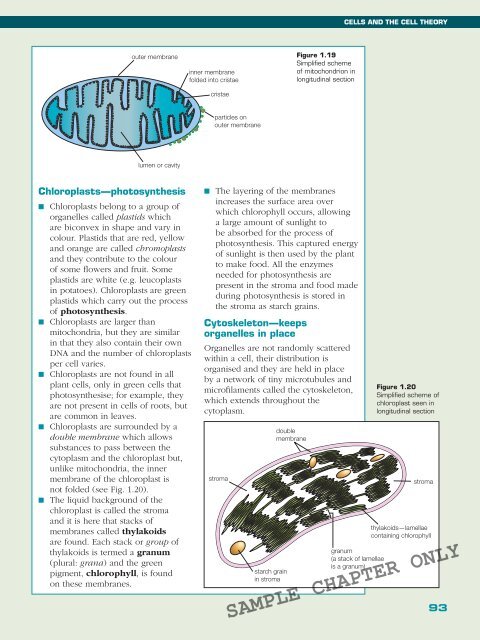BIOLOGY IN FOCUS
BIOLOGY IN FOCUS
BIOLOGY IN FOCUS
You also want an ePaper? Increase the reach of your titles
YUMPU automatically turns print PDFs into web optimized ePapers that Google loves.
CELLS AND THE CELL THEORY<br />
outer membrane<br />
inner membrane<br />
folded into cristae<br />
cristae<br />
Figure 1.19<br />
Simplified scheme<br />
of mitochondrion in<br />
longitudinal section<br />
particles on<br />
outer membrane<br />
lumen or cavity<br />
Chloroplasts—photosynthesis<br />
■ Chloroplasts belong to a group of<br />
organelles called plastids which<br />
are biconvex in shape and vary in<br />
colour. Plastids that are red, yellow<br />
and orange are called chromoplasts<br />
and they contribute to the colour<br />
of some flowers and fruit. Some<br />
plastids are white (e.g. leucoplasts<br />
in potatoes). Chloroplasts are green<br />
plastids which carry out the process<br />
of photosynthesis.<br />
■ Chloroplasts are larger than<br />
mitochondria, but they are similar<br />
in that they also contain their own<br />
DNA and the number of chloroplasts<br />
per cell varies.<br />
■ Chloroplasts are not found in all<br />
plant cells, only in green cells that<br />
photosynthesise; for example, they<br />
are not present in cells of roots, but<br />
are common in leaves.<br />
■ Chloroplasts are surrounded by a<br />
double membrane which allows<br />
substances to pass between the<br />
cytoplasm and the chloroplast but,<br />
unlike mitochondria, the inner<br />
membrane of the chloroplast is<br />
not folded (see Fig. 1.20).<br />
■ The liquid background of the<br />
chloroplast is called the stroma<br />
and it is here that stacks of<br />
membranes called thylakoids<br />
are found. Each stack or group of<br />
thylakoids is termed a granum<br />
(plural: grana) and the green<br />
pigment, chlorophyll, is found<br />
on these membranes.<br />
■ The layering of the membranes<br />
increases the surface area over<br />
which chlorophyll occurs, allowing<br />
a large amount of sunlight to<br />
be absorbed for the process of<br />
photosynthesis. This captured energy<br />
of sunlight is then used by the plant<br />
to make food. All the enzymes<br />
needed for photosynthesis are<br />
present in the stroma and food made<br />
during photosynthesis is stored in<br />
the stroma as starch grains.<br />
Cytoskeleton—keeps<br />
organelles in place<br />
Organelles are not randomly scattered<br />
within a cell, their distribution is<br />
organised and they are held in place<br />
by a network of tiny microtubules and<br />
microfilaments called the cytoskeleton,<br />
which extends throughout the<br />
cytoplasm.<br />
<br />
<br />
<br />
<br />
<br />
<br />
<br />
<br />
Figure 1.20<br />
Simplified scheme of<br />
chloroplast seen in<br />
longitudinal section<br />
<br />
<br />
<br />
SAMPLE CHAPTER ONLY<br />
93
















